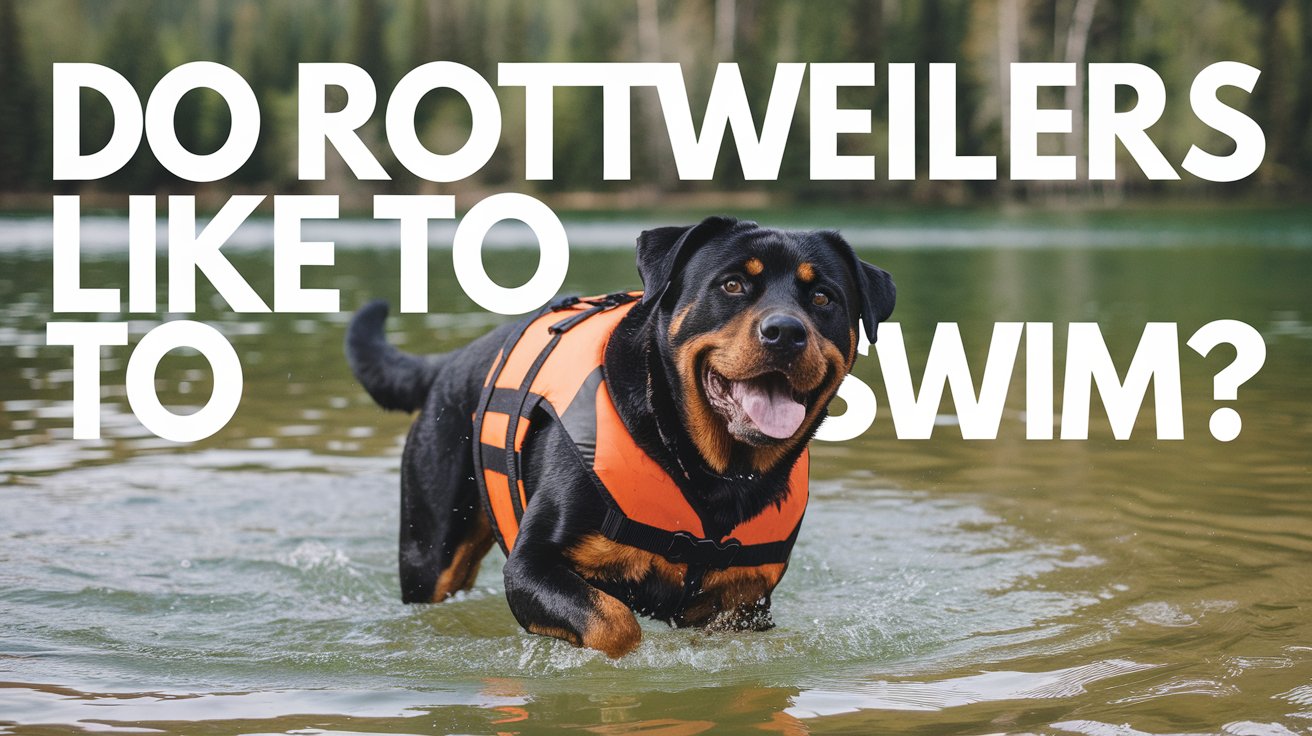Do Rottweilers Like to Swim? Key Takeaways 🌟
-
-
Smart Introduction: Start with kiddie pools in the morning, use treats, and progress slowly to deeper water.
-
Health Benefits: Low-impact exercise that's great for joints, weight control, and heart health while keeping them cool.
-
Warning Signs: Watch for heavy panting, trembling muscles, and reluctant behavior - know when to stop.
-
Individual Pace: Every Rottweiler's swimming journey is different - patience and positive reinforcement are key.
Do Rottweilers like to swim? As a veterinarian and longtime Rottweiler owner, I can tell you that the answer is more complex than a simple yes or no. While they may not be natural water dogs like Retrievers, Rottweilers possess unique physical traits and instincts that can make them surprisingly adept swimmers. Let me share some insights from my veterinary practice and personal experience that might change how you view your Rottie and their potential in the water.
Now, let’s dive deeper into why people often misjudge a Rottweiler’s swimming abilities.
The Hidden Swimming Potential of Rottweilers
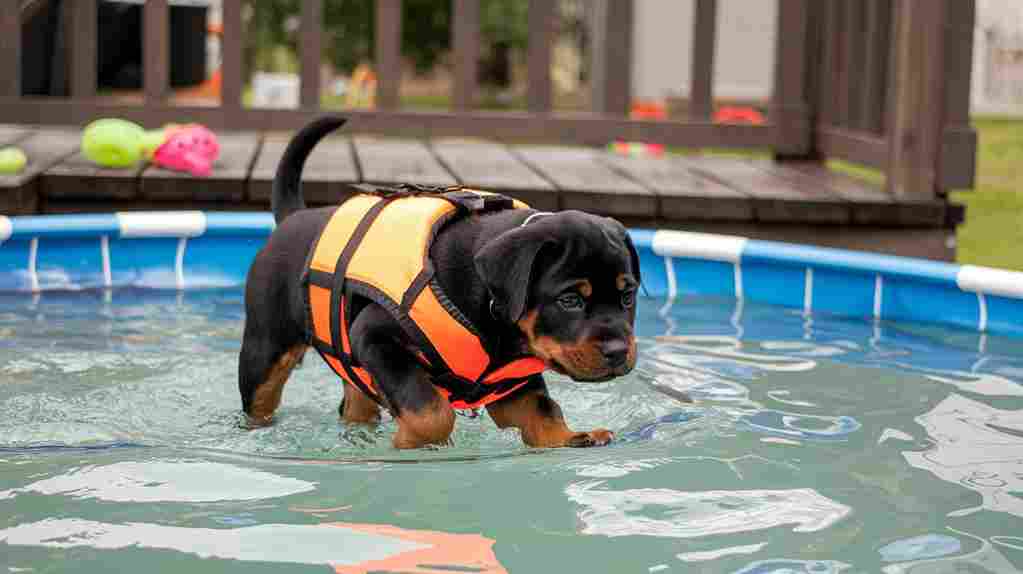
Here’s what most people get wrong – a Rottweiler’s muscular build isn’t the swimming obstacle many assume it to be.
During my years at the veterinary rehabilitation center, I’ve observed something fascinating: their powerful chest muscles and broad shoulder structure can actually be advantageous in water. While they’re not naturally drawn to water like retrievers, their physical capabilities in the water often exceed owners’ expectations.
Contrary to popular belief, Rottweilers are actually capable swimmers. The American Kennel Club clarifies that while they may not be as instinctively drawn to water as some breeds, Rottweilers possess the physical attributes and strength to swim effectively. Their powerful bodies and broad chests, often seen as hindrances, can actually be advantageous in the water, providing them with the necessary propulsion and stability.
Based on both clinical observations and my experience with my own Rottweiler, Max, I’ve seen how these dogs can develop a remarkable comfort level in water when introduced properly. What makes this especially interesting is how their anatomical structure, often viewed as a limitation, can become an asset in aquatic activities.
But it’s not just about their build. There’s a fascinating scientific explanation for how Rottweilers swim!
The Science Behind Rottweiler Swimming Abilities
During my veterinary practice, I’ve noticed something remarkable about Rottweiler physiology that few owners understand. Their dense muscle mass, which accounts for about 60% of their body weight, creates a unique swimming dynamic. Unlike naturally buoyant breeds like Labradors, Rottweilers need to engage their muscles more actively, resulting in a more intensive workout. To illustrate this point, let me share my own experience with my Rottweiler, Max:
My Personal Journey With Max: From Fear to Confidence
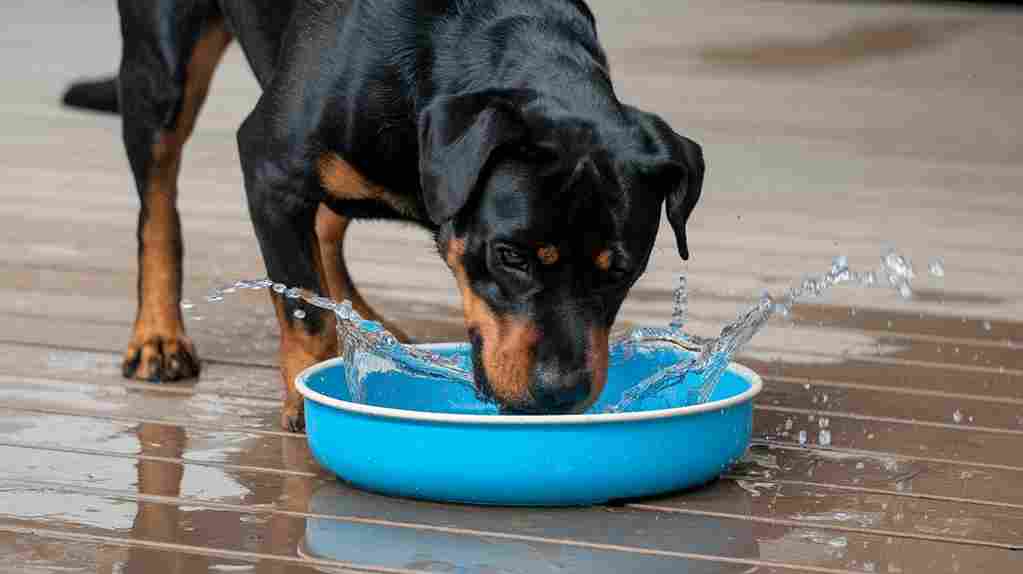
Let me share a story about my Rottweiler, Max – it might help you with your own pup! When I first got him, he was absolutely terrified of our backyard pool. Like, wouldn’t even go near it. And here’s the funny thing – even with all my vet training, I was pretty nervous about teaching him to swim.
But then something amazing happened. I noticed Max would always play with his water bowl, splashing around like a little kid. That’s when it hit me – why not start there? Here’s what worked for us:
- We started super small with a tiny kiddie pool (honestly, watching a 110-pound Rottie tiptoeing around a plastic pool is hilarious!)
- Made it fun with his favorite toys floating around
- Used lots of treats (freeze-dried liver became his “pool party” special)
- Eventually moved to shallow lake edges where he could touch bottom
Why Some Rotties Love Water (And Others... Not So Much!)
Now, you might be wondering why some Rottweilers seem to take to water naturally while others are more hesitant. After seeing hundreds of Rotties in my practice and hanging out with my own water-loving goofball, here’s what I’ve noticed:
- Some Rotties are just built different! A few have what I call a “swimmer’s build” – they’re naturally more buoyant
- Getting them used to water as puppies (around 8-16 weeks) makes a HUGE difference
- Every Rottie has their own personality – some are total daredevils, others need more convincing (and that’s totally okay!)
Beyond the sheer joy of watching your Rottie splash around, there are some incredible health benefits to swimming:
The Awesome Benefits of Swimming (That I've Seen Firsthand)
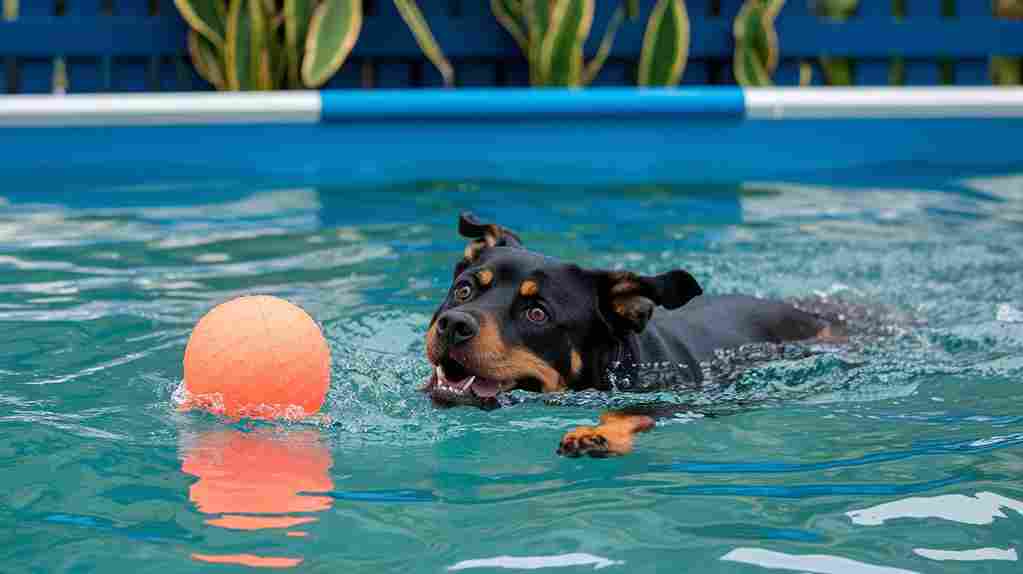
Let me tell you why swimming is such a fantastic exercise for our big friends:
- It’s super gentle on their joints – like running on clouds!
- Works out their muscles without the usual strain
- Helps them cool off (because let’s face it, that black fur gets HOT)
- Great for their heart health without the impact of running
Ready to help your Rottweiler become a confident swimmer? Here are some tried-and-true tips:
Tips That Actually Work (From Years of Trial and Error!)
Let me share some tricks that have worked like magic with my Rottie patients (and my own big goofball):
- Morning Swims Are Best: Ever notice how your Rottie has that extra bounce in the morning? That’s the perfect time for swimming! Aim for before 10 AM when they’re full of energy
- Treats Are Your Secret Weapon: Freeze-dried liver treats are like underwater gold to these guys! Keep them handy
- Clear Water is Key: They love being able to see what’s going on – wouldn’t you?
- Watch That Tail: It’s like their mood ring! Happy, relaxed tail = good to go. Tucked tail = time to slow down
The "Monkey See, Monkey Do" Method
Here’s a cool trick I discovered by accident – Rotties are total copycats! And I mean that in the best way possible. Here’s what works amazing:
- Let them watch other dogs having a blast in the water
- Get in there yourself! If they see you enjoying the water, they’ll get curious
- Make a big happy fuss when other dogs are swimming (your Rottie will totally want in on the fun!)
While it’s exciting to introduce your Rottie to the water, there are some common mistakes that can hinder their progress or even create negative associations.
Common Oopsies to Avoid (We've All Made Them!)
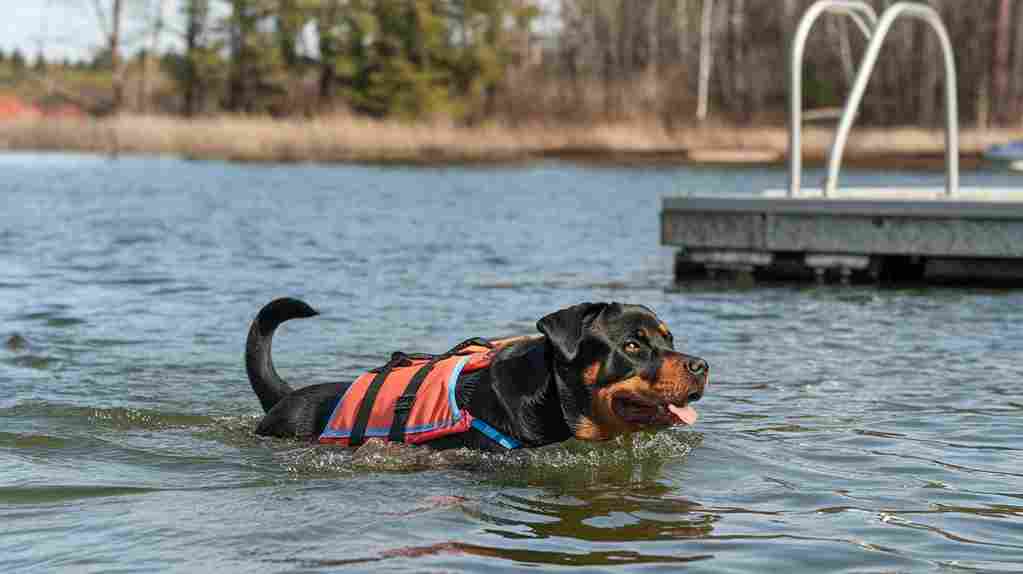
After years of seeing Rotties in my practice, here are the most common “whoops” moments:
- The Temperature Trap: Just because they’re big and tough doesn’t mean they love cold water! Their thick coat actually makes them pretty sensitive
- The Marathon Mistake: These muscly pups tire out faster than you’d think – lots of short breaks are better than one long swim
- The Life Jacket Mix-Up: Those broad chests need special fitting – one size definitely does not fit all!
- The Push and Pray: Never force them in! Trust me, I learned this one the hard way 😅
Setting Up The Perfect Splash Zone
To set your Rottweiler up for success, it’s important to create a safe and inviting swimming environment. Let me share some easy tricks to make swimming super fun and safe for your Rottie (these worked wonders with my Max!):
- Easy In, Easy Out: Make sure they can get out easily – think of it like having multiple “emergency exits.” My Max always feels braver knowing he can hop out whenever he wants!
- Crystal Clear is Best: Your Rottie sees better in clear water – it’s like the difference between walking in broad daylight vs. foggy weather
- No-Slip Zone: Put some non-slip mats around the area. Nothing spooks a Rottie like feeling wobbly!
- Chill-Out Spots: Create some shallow areas where they can just stand and catch their breath. Think of it as their personal “rest stop”
While encouraging your Rottweiler to enjoy the water is important, it’s equally crucial to recognize when they need a break.
When to Hit the Brakes (Warning Signs Every Owner Should Know)
Even if your Rottweiler seems to be having a blast in the water, it’s crucial to monitor them closely for signs of fatigue or overexertion. Remember, these powerful pups can tire out more quickly than you might think, especially when they’re first learning to swim. Here are some key warning signs to watch for:
- Heavy Panting: If your Rottie is panting excessively, with their tongue hanging out and their sides heaving, it’s a clear sign they need a break.
- Glazed Eyes or a Fixed Stare: A far-off look in their eyes or a fixed stare can indicate they’re becoming disoriented or overwhelmed.
- Trembling Muscles: If you notice their muscles trembling or shaking, especially in their legs or hindquarters, it’s time to get them out of the water.
- Reluctance to Continue: If your Rottie suddenly seems hesitant to swim, tries to turn back, or shows signs of anxiety, it’s important to respect their signals and end the session.
- Whining or Whimpering: Vocalizations like whining or whimpering can indicate discomfort or distress.
- Changes in Swimming Style: If your Rottie’s swimming becomes uncoordinated, erratic, or they start struggling to stay afloat, it’s a sign they’re tiring out.
Remember: It’s always better to err on the side of caution and end a swim session early if you have any concerns about your Rottweiler’s well-being. Never force them to stay in the water if they show signs of wanting to get out.
Final Thoughts (From Your Friendly Neighborhood Vet)
You know what’s really cool about teaching Rotties to swim? It’s like watching a friend discover something awesome! Here’s what I want you to take home:
- Every Rottie Has Their Story: Max went from totally scared to loving his pool time. Your pup might be faster or slower – and both are perfectly fine!
- Safety = Fun: When they feel safe, they have more fun. It’s that simple!
- Patience Pays Off: Some of my most water-shy patients became total beach bums with time and patience
My Personal Promise to You
After years of working with these amazing dogs, here’s what I can promise: if you follow these tips and keep things positive, you’ll either end up with:
- A water-loving Rottie who can’t wait for swim time
- OR a happy pup who knows swimming isn’t their thing (but loves you for trying!)
Both outcomes are perfect! 🐾
Quick Start Guide (Pin This to Your Fridge!)
Here’s your super-quick checklist for success:
- ✓ Get that perfect-fit life jacket
- ✓ Start in the morning when they’re peppy
- ✓ Keep treats handy (lots of them!)
- ✓ Watch for tired signals
- ✓ Celebrate EVERY little progress
Frequently Asked Questions
Can Rottweilers naturally swim?
Yes, Rottweilers can swim naturally, but their muscular build means they might need more practice and support initially. While they're not natural water dogs like Labradors, many Rottweilers can become confident swimmers with proper training and introduction.
What age should I start teaching my Rottweiler to swim?
The ideal time to introduce your Rottweiler to water is during their critical development period (8-16 weeks). However, adult Rottweilers can also learn to swim - it just might take more patience and consistent training.
Do I really need a dog life jacket for my Rottweiler?
Yes! Despite their strength, Rottweilers' muscular build makes them less naturally buoyant than other breeds. A properly fitted life jacket provides:
- Extra safety
- Confidence boost
- Support for longer swimming sessions
- Peace of mind for both owner and dog
How often should my Rottweiler swim?
For beginners, start with 5-minute sessions, 2-3 times per week. As they build endurance, you can increase to 15-20 minute sessions. Always monitor for signs of fatigue and never force longer sessions.
Why does my Rottweiler seem afraid of water?
Fear of water in Rottweilers often stems from:
- Lack of early exposure
- A previous negative experience
- Natural caution around new experiences
- The key is patience and positive reinforcement - never force them into the water.
Ready to take your Rottweiler’s training to the next level? Learn more about [advanced Rottweiler training] and unlock your companion’s full potential. From agility courses to scent work, this guide provides step-by-step instructions and expert advice.


